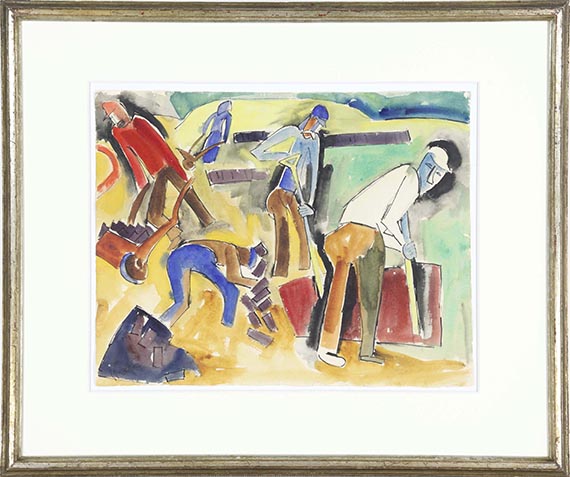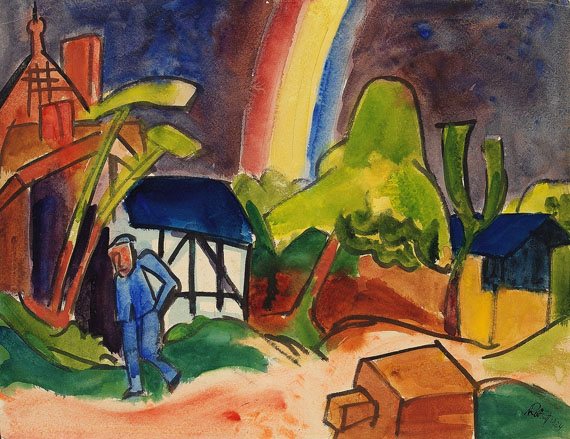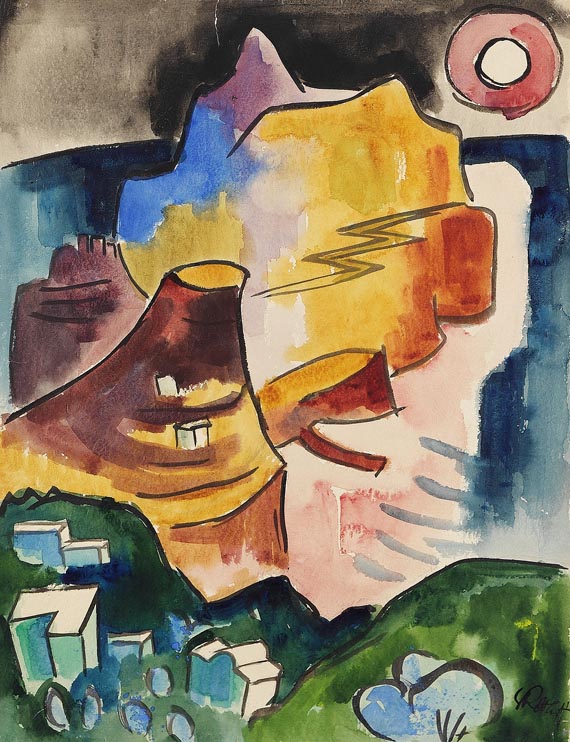425
Karl Schmidt-Rottluff
Beim Torfstechen, 1922.
Watercolor and ink pen
Stima: € 30,000 / $ 32,100
Beim Torfstechen. 1922.
Watercolor and ink pen.
Lower left signed and dated. Titled on the reverse. On off-white watercolor paper. 47.7 x 60.5 cm (18.7 x 23.8 in), the full sheet. [CH].
• Elaborate, colorful watercolor of painting-like effect.
• In 1989 part of the grand retrospective at the Lenbachhaus in Munich and the Kunsthalle Bremen.
• Using strong colors, peat blocks abstracted into geometric shapes, the arrangement of the peat diggers' dynamic action and the direct gaze of the right figure, Schmidt-Rottluff creates a fascinating composition.
• The artist spent most summers between 1920 and 1931 in Jershöft in Eastern Pommerania on the Baltic Sea, with its characteristic bogs and marsh-lands.
The work is documented in the archive of the Karl and Emy Schmidt-Rottluff Foundation, Berlin.
PROVENANCE: Kunsthütte Chemnitz (1923 - August 19, 1937, with the inventory number on the reverse).
State-owned (confiscated from the above in context of the "Degenerat Art" campaign in 1937, EK no. 17644-E).
Frankfurter Kunstkabinett Hanna Bekker vom Rath, Frankfurt a.M.
Hermann Gerlinger Collection, Würzburg (acquired from the above in 1988, with the collector's stamp, Lugt 6032).
EXHIBITION: Karl Schmidt-Rottluff 1884-1976. Malerei und Graphik - Werke im Besitz der Städtischen Kunstsammlung Karl-Marx-Stadt, Karl-Marx-Stadt 1982, p. 78 (illu.).
Karl Schmidt-Rottluff. Retrospektive, Kunsthalle Bremen, July 16 - September 10, 1989, Städtische Galerie im Lenbachhaus, Munich, September 27 - December 3, 1989, cat. no. 249 (illu., p. 268).
Expressiv! Die Künstler der Brücke. Die Sammlung Hermann Gerlinger, Albertina Vienna, June 1 - August 26, 2007, p. 110, cat. no. 61 (illu.).
LITERATURE: Heinz Spielmann (ed.), Die Maler der Brücke. Sammlung Hermann Gerlinger, Stuttgart 1995, p. 398, SHG no. 693 (illu).
Hermann Gerlinger, Katja Schneider (eds.), Die Maler der Brücke. Inventory catalog Hermann Gerlinger Collection, Halle (Saale) 2005, p. 99, SHG no. 207 (illu.)
www.geschkult.fu-berlin.de/e/db_entart_kunst/datenbank (EK no. 17644-E).
Called up: June 8, 2024 - ca. 17.33 h +/- 20 min.
Watercolor and ink pen.
Lower left signed and dated. Titled on the reverse. On off-white watercolor paper. 47.7 x 60.5 cm (18.7 x 23.8 in), the full sheet. [CH].
• Elaborate, colorful watercolor of painting-like effect.
• In 1989 part of the grand retrospective at the Lenbachhaus in Munich and the Kunsthalle Bremen.
• Using strong colors, peat blocks abstracted into geometric shapes, the arrangement of the peat diggers' dynamic action and the direct gaze of the right figure, Schmidt-Rottluff creates a fascinating composition.
• The artist spent most summers between 1920 and 1931 in Jershöft in Eastern Pommerania on the Baltic Sea, with its characteristic bogs and marsh-lands.
The work is documented in the archive of the Karl and Emy Schmidt-Rottluff Foundation, Berlin.
PROVENANCE: Kunsthütte Chemnitz (1923 - August 19, 1937, with the inventory number on the reverse).
State-owned (confiscated from the above in context of the "Degenerat Art" campaign in 1937, EK no. 17644-E).
Frankfurter Kunstkabinett Hanna Bekker vom Rath, Frankfurt a.M.
Hermann Gerlinger Collection, Würzburg (acquired from the above in 1988, with the collector's stamp, Lugt 6032).
EXHIBITION: Karl Schmidt-Rottluff 1884-1976. Malerei und Graphik - Werke im Besitz der Städtischen Kunstsammlung Karl-Marx-Stadt, Karl-Marx-Stadt 1982, p. 78 (illu.).
Karl Schmidt-Rottluff. Retrospektive, Kunsthalle Bremen, July 16 - September 10, 1989, Städtische Galerie im Lenbachhaus, Munich, September 27 - December 3, 1989, cat. no. 249 (illu., p. 268).
Expressiv! Die Künstler der Brücke. Die Sammlung Hermann Gerlinger, Albertina Vienna, June 1 - August 26, 2007, p. 110, cat. no. 61 (illu.).
LITERATURE: Heinz Spielmann (ed.), Die Maler der Brücke. Sammlung Hermann Gerlinger, Stuttgart 1995, p. 398, SHG no. 693 (illu).
Hermann Gerlinger, Katja Schneider (eds.), Die Maler der Brücke. Inventory catalog Hermann Gerlinger Collection, Halle (Saale) 2005, p. 99, SHG no. 207 (illu.)
www.geschkult.fu-berlin.de/e/db_entart_kunst/datenbank (EK no. 17644-E).
Called up: June 8, 2024 - ca. 17.33 h +/- 20 min.
The artist spent most of the summers between 1920 and 1931 in Jershöft on the Baltic Sea in Eastern Pomeranian, not far from the peat bogs and marshes characteristic of the Pomeranian Lake District. The small fishing and farming village provided the artist with a sense of calm during a very turbulent post-war period, especially in light of the emerging extremist groups in Weimar politics and above all in his home city of Berlin. Hence, Schmidt-Rottluff devoted his creation to rural life. Works depicting workers, farmers or fishermen going about their daily chores become the motif of his painting and depict people in their social environment.
In these paintings of workers, craftsmen and fishermen, Schmidt-Rottluff conceived a colorful surface painting. Zones of pure colors interlock and give a dynamic rhythm to the surface. At times, the forms even seem to dissolve into an almost colorful abstraction within the surface, whereby reference to the actual motif always remains. The artist also uses the dark contours to define different shapes and creates a certain spatiality through the order of the individual parts of the picture. Spacious, simplified, almost geometrically rendered forms and large surface areas determine the character of the composition, which Schmidt-Rottluff also takes up, for example, in the similar painting "Fischer mit roten Netzen" (1921, part of the Hermann Gerlinger Collection until 2023). In the watercolor offered here, however, the artist does not depict the fishing activity, but rather the physically hard work of cutting peat, depicting the people without the usual physiognomy in an expressive movement. These are rhythmic pictorial processes that appear in his works for the first time. Nevertheless, something of the expressive surface style of the pre-war period echoes in the works of the post-war years, but the works create a far more emotional, less serene impression. [MvL]
In these paintings of workers, craftsmen and fishermen, Schmidt-Rottluff conceived a colorful surface painting. Zones of pure colors interlock and give a dynamic rhythm to the surface. At times, the forms even seem to dissolve into an almost colorful abstraction within the surface, whereby reference to the actual motif always remains. The artist also uses the dark contours to define different shapes and creates a certain spatiality through the order of the individual parts of the picture. Spacious, simplified, almost geometrically rendered forms and large surface areas determine the character of the composition, which Schmidt-Rottluff also takes up, for example, in the similar painting "Fischer mit roten Netzen" (1921, part of the Hermann Gerlinger Collection until 2023). In the watercolor offered here, however, the artist does not depict the fishing activity, but rather the physically hard work of cutting peat, depicting the people without the usual physiognomy in an expressive movement. These are rhythmic pictorial processes that appear in his works for the first time. Nevertheless, something of the expressive surface style of the pre-war period echoes in the works of the post-war years, but the works create a far more emotional, less serene impression. [MvL]
425
Karl Schmidt-Rottluff
Beim Torfstechen, 1922.
Watercolor and ink pen
Stima: € 30,000 / $ 32,100
Commissione, tassa e diritti di seguito
Quest'oggetto viene offerto con regime fiscale normale o con imposizione sul margine di profitto.
Calcolo commissione particolare sul margine del profitto:
- Prezzo d’aggiudicazione fino a 800.000 euro: provvigione del 32%.
- Per la parte del prezzo d’aggiudicazione superiore a 800.000 euro si calcola una provvigione del 27%, che viene aggiunta a quella relativa alla parte del prezzo d’aggiudicazione fino a 800.000 euro.
- Per la parte del prezzo d’aggiudicazione superiore a 4.000.000 euro si calcola una provvigione del 22%, che viene aggiunta a quella relativa alla parte del prezzo d’aggiudicazione fino a 4.000.000 euro.
Il prezzo d’acquisto comprende l’imposta sul valore aggiunto in vigore in quel momento, attualmente il 19%.
Calcolo regime fiscale normale:
Prezzo di aggiudicazione fino a 800.000 €: supplemento del 27%, più l´IVA legale
Prezzo di aggiudicazione superiore a 800.000 €: Parte del prezzo fino a 800.000 € supplemento del 27 %, parte del prezzo che supera i 800.000 € supplemento del 21%, a talvolta maggiorato dell'IVA legale.
Prezzo di aggiudicazione superiore a 4.000.000 €: Parte del prezzo che supera i 4.000.000 € supplemento del 15%, a talvolta maggiorato dell'IVA legale.
La preghiamo di avvisarci prima della fatturazione nel caso in cui desidera applicare il regime fiscale normale.
Calcolo diritti di seguito:
Per le opere originali di arti figurative e fotografie di artisti viventi o deceduti da meno di 70 anni soggette al diritto di seguito, in tutti i casi suddetti viene riscossa in aggiunta, a liquidazione della compensazione del diritto di seguito dovuto dalla casa d'aste ai sensi del § 26 della legge tedesca sul diritto d'autore (Urheberrechtsgesetz, UrhG), una compensazione del diritto di seguito con le percentuali indicate nel § 26 2° comma UrhG, che attualmente sono le seguenti:
4 per cento della parte del ricavo della vendita da 400,00 euro a 50.000 euro,
un altro 3 per cento della parte del ricavo della vendita da 50.000,01 a 200.000 Euro,
un altro 1 per cento della parte del ricavo della vendita da 200.000,01 a 350.000 Euro,
un altro 0,5 per cento della parte del ricavo della vendita da 350.000,01 a 500.000 euro e
un altro 0,25 per cento della parte del ricavo della vendita superiore a 500.000 euro.
L’importo complessivo della compensazione del diritto di seguito derivante da una rivendita è pari al massimo a 12.500 euro.
Calcolo commissione particolare sul margine del profitto:
- Prezzo d’aggiudicazione fino a 800.000 euro: provvigione del 32%.
- Per la parte del prezzo d’aggiudicazione superiore a 800.000 euro si calcola una provvigione del 27%, che viene aggiunta a quella relativa alla parte del prezzo d’aggiudicazione fino a 800.000 euro.
- Per la parte del prezzo d’aggiudicazione superiore a 4.000.000 euro si calcola una provvigione del 22%, che viene aggiunta a quella relativa alla parte del prezzo d’aggiudicazione fino a 4.000.000 euro.
Il prezzo d’acquisto comprende l’imposta sul valore aggiunto in vigore in quel momento, attualmente il 19%.
Calcolo regime fiscale normale:
Prezzo di aggiudicazione fino a 800.000 €: supplemento del 27%, più l´IVA legale
Prezzo di aggiudicazione superiore a 800.000 €: Parte del prezzo fino a 800.000 € supplemento del 27 %, parte del prezzo che supera i 800.000 € supplemento del 21%, a talvolta maggiorato dell'IVA legale.
Prezzo di aggiudicazione superiore a 4.000.000 €: Parte del prezzo che supera i 4.000.000 € supplemento del 15%, a talvolta maggiorato dell'IVA legale.
La preghiamo di avvisarci prima della fatturazione nel caso in cui desidera applicare il regime fiscale normale.
Calcolo diritti di seguito:
Per le opere originali di arti figurative e fotografie di artisti viventi o deceduti da meno di 70 anni soggette al diritto di seguito, in tutti i casi suddetti viene riscossa in aggiunta, a liquidazione della compensazione del diritto di seguito dovuto dalla casa d'aste ai sensi del § 26 della legge tedesca sul diritto d'autore (Urheberrechtsgesetz, UrhG), una compensazione del diritto di seguito con le percentuali indicate nel § 26 2° comma UrhG, che attualmente sono le seguenti:
4 per cento della parte del ricavo della vendita da 400,00 euro a 50.000 euro,
un altro 3 per cento della parte del ricavo della vendita da 50.000,01 a 200.000 Euro,
un altro 1 per cento della parte del ricavo della vendita da 200.000,01 a 350.000 Euro,
un altro 0,5 per cento della parte del ricavo della vendita da 350.000,01 a 500.000 euro e
un altro 0,25 per cento della parte del ricavo della vendita superiore a 500.000 euro.
L’importo complessivo della compensazione del diritto di seguito derivante da una rivendita è pari al massimo a 12.500 euro.




 Lot 425
Lot 425 


